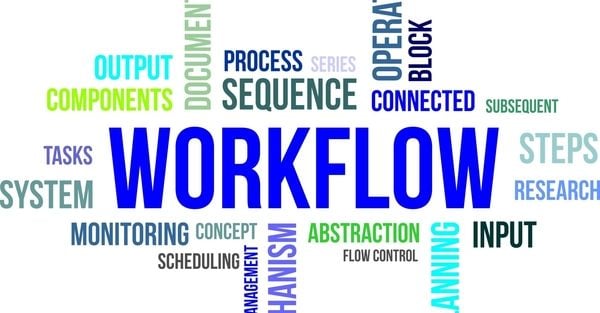
Tips for Getting the Most from a Cybersecurity Assessment
March 19, 2019
What Data Center Professionals Need to Know about Liquid Cooling
March 20, 2019Data centers are chiefly known for being the storage location of large volumes of data. To ensure that data is transmitted seamlessly from the data center to servers and computer systems in different areas, there needs to be a workflow. Data center workflow refers to the service-oriented and dynamic processes that occur within data centers.
It can also be the process through which typical data center tasks get expedited in a consistent, orderly, and effective manner. The processes that take place in data centers inform the team in-charge about what needs to be done and what is required. Similarly, it tracks tasks as they get completed.
What Does Data Center Workflow Entail?
Modern data centers are complex facilities, which are ever evolving. Typically, assets are regularly added, shifted, changed, and even decommissioned daily. To ensure a smooth workflow, there’s a need for a centralized view to not only plan but also manage all the changes. It’s only by doing this that managers will optimize operations.
For all processes within a data center to happen, resources need to be optimized. Data center workflow also entails the optimization of resources that are required to perform tasks. This included time and equipment. When data center managers have updated lists of who is responsible for which task, individuals will work more efficiently and productively.
Workflow similarly streamlines operations such as technology refresh remediation. Changes that typically occur in critical facilities like data centers are costly. By simplifying operations during the process of implementing any changes, workflow plays a significant role in reducing the expenses involved.

Tasks performed within every data center, are both computing and non-computing in nature. Either way, these tasks are critical to the day to day operations of the facility. They include all manual and automated processes that are essential to keeping the facility operational. Typically, these processes are distributed across different categories such as:
- Security. Data centers provide storage to millions of data files. Therefore, the facilities require tools and processes that guarantee their logical and physical security.
- Infrastructure Operations. For effective workflow at a data center, network and storage resources ought to be installed, maintained, monitored, and patched. Similarly, servers should be updated regularly.
- Management. There’s a need to create, enforce, and track policies and procedures within a data center to optimize workflow. This is the role that data center managers play.
- Power and Cooling. For optimal data center workflow, there needs to be an adequate power supply. Likewise, the cooling system must be operational.
How to Improve Data Center Workflow
Optimizing data center workflow should be the first priority for facility managers. Improving data center operations will go a long way in enhancing the overall performance of your business. Therefore, data center managers ought to continually seek opportunities for increasing operational efficiency. This will also reduce costs as well as improving efficiency. Here’s how to improve data center workflow.
Optimize IT Power
Data centers comprise intricate IT systems that require constant power delivery. Nonetheless, facility managers ought to reduce payload power. On average, 60% of payload power gets consumed by servers. This underlines the significance of reducing the energy consumed by servers.
Optimize Space
Data centers that were built before server virtualization was advanced may be overbuilt for the equipment needs of today. Such data centers tend to have large equipment, which nonetheless, are outdated. You can optimize space at your data center by getting rid of old IT equipment and replacing them with those that take up less space and require less IT power.
When building a data center at an age when server virtualization has taken root, you should consider using a modular design. Such a model breaks down the facility into individual modules, which can be continually revitalized as part of an organic and more flexible data center design.
Optimizing Cooling
Data center components need to be continuously kept cool to ensure that they work optimally without breaking down. To achieve maximum efficiency at your facility, ensure that data center cooling best practices are adopted. You can do this by:
- Installing Economizers. If your data center is located in a cold region, you may only need an air economizer. This will improve PUE significantly. In most areas of North America, for instance, you can use air economizers to fulfill 40%-90% of your cooling needs.
- Contain Your Equipment and Heat. To optimize cooling at data centers, consider building isolation structures to house components that generate a lot of heat. Similarly, construct structures for funneling that heat out of your data center.
- Optimize AC Systems. Generally, there are two primary ways of optimizing AC systems in data centers. For instance, turning off the AC system periodically and finding an alternative cooling source such as air optimizers will go a long way in reducing the overall energy consumption of your data center.
Even as you think of optimizing cooling at your facility, you should devise ways of eliminating power and cooling inefficiencies at your data center. Archaic power delivery systems such as transformers, power distribution units (PDUs), and uninterruptible power supplies (UPS), can significantly affect the facility’s PUE ratios.
Therefore, you should evaluate your current power needs as well as future requirement. This will help you pinpoint modern alternatives that can alleviate your heating and cooling costs. These alternatives require significant investment in terms of time and resources. Nonetheless, they can generate a good ROI besides ensuring optimal data center workflow.
Why Data Center Managers Should Know Where They Stand
To ensure that all systems are working optimally at their data centers, managers ought to know where they stand. Often, data center workflow is hindered by performance issues. It’s good practice to continually track everything that happens in a data center so that errors get corrected.
Managers ought to keep in mind the fact that data center workflow depends on the speed and reliability with which they play their oversight role over the facilities. By implementing the right processes and reporting tools, it will be easy to measure operational performance at data centers, thus optimizing workflow.
Managing a data center requires a lot of work. Managers should take a proactive approach to ensure that performance isn’t affected even when undertaking regular maintenance tasks at the facility. In any data center, up to 30% of servers get replaced every year. It is the role of data center managers to oversee the maintenance of equipment to optimize workflow. Similarly, all changed made should be documented.

